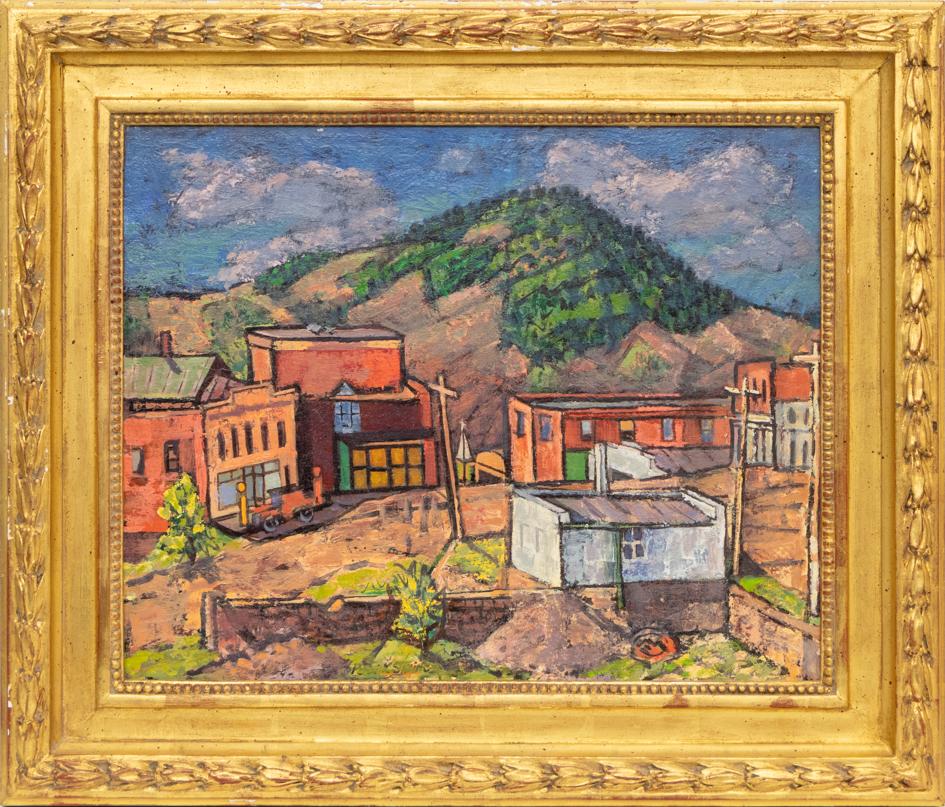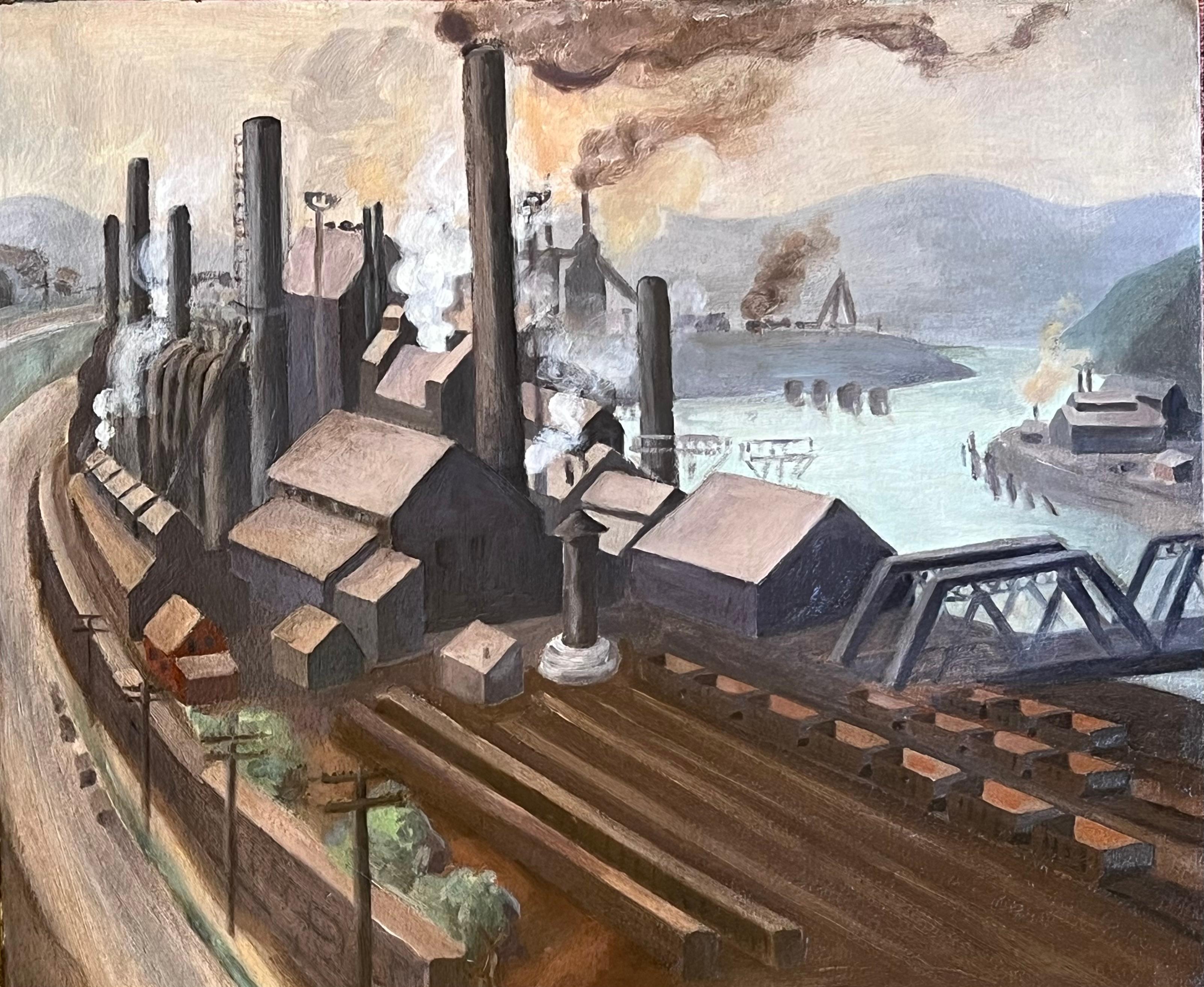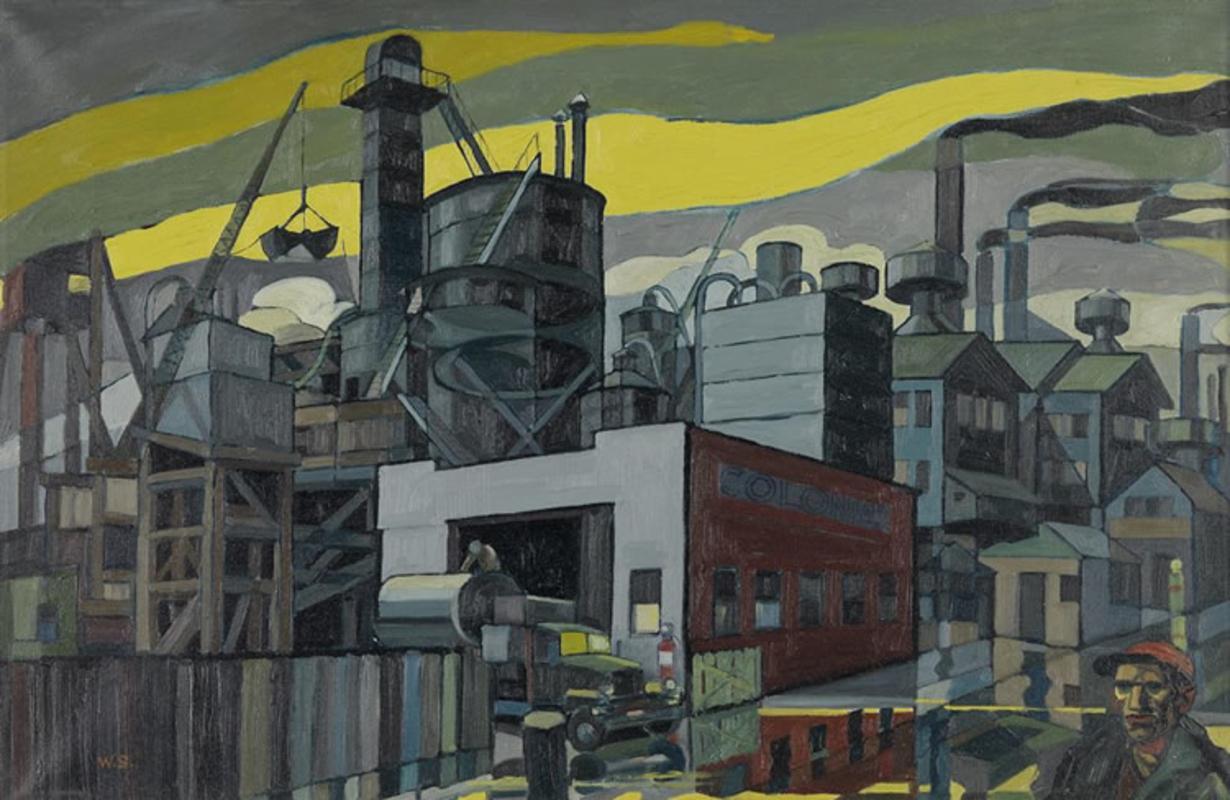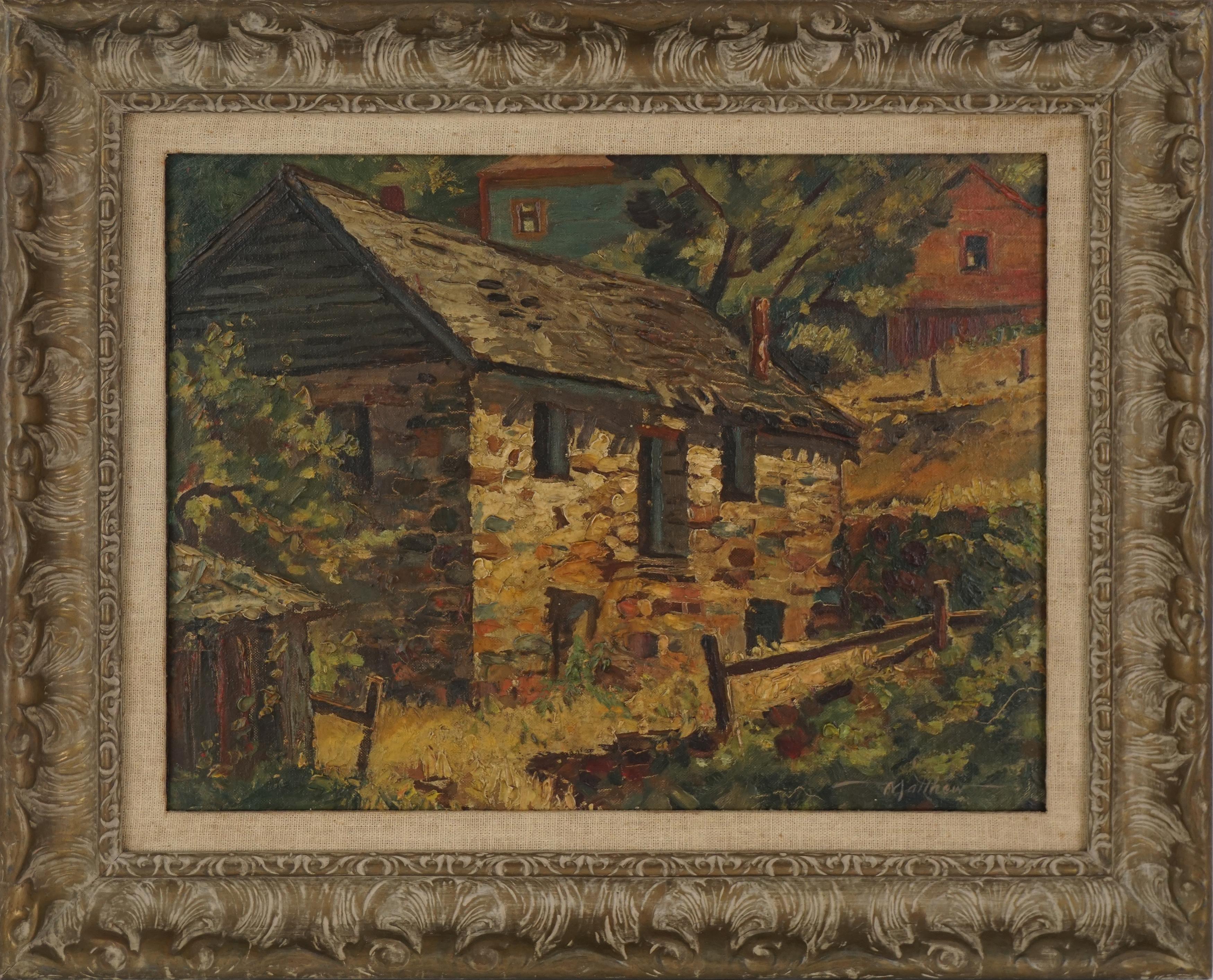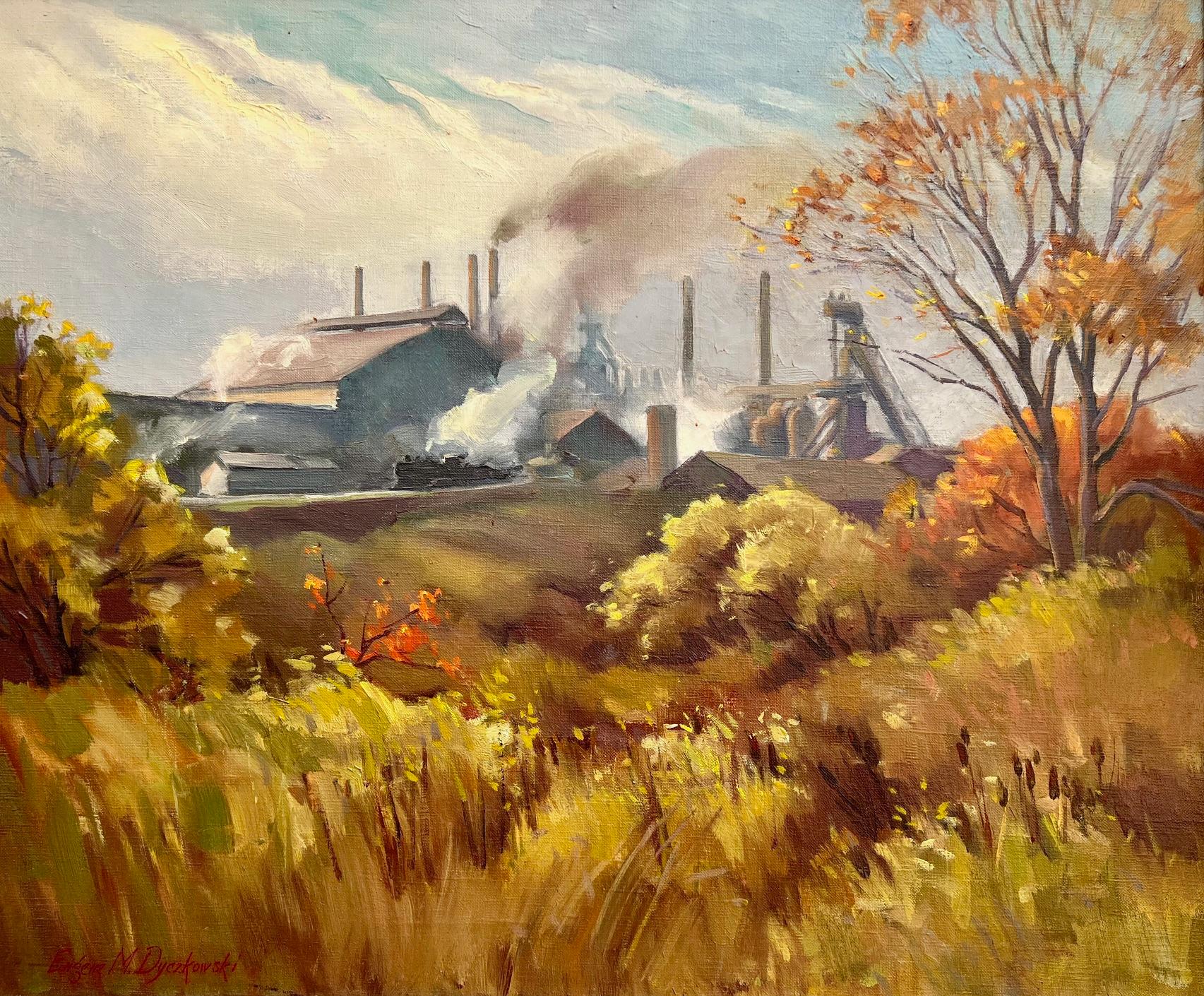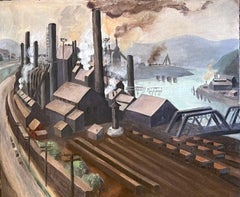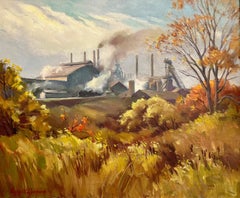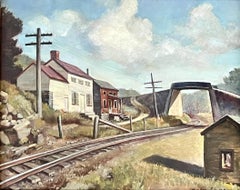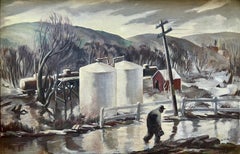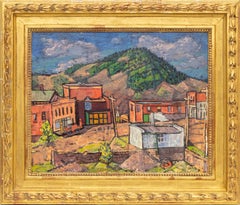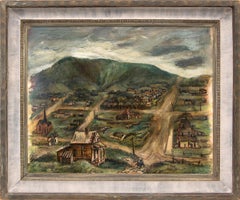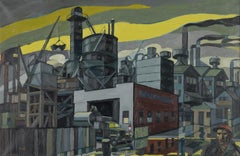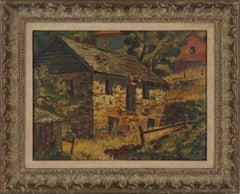Items Similar to Goldmine, Central City, Colorado
Want more images or videos?
Request additional images or videos from the seller
1 of 6
Joseph MeertGoldmine, Central City, Coloradoc. 1936-1938
c. 1936-1938
$27,500
£20,686.59
€23,964.46
CA$38,769.31
A$43,114.06
CHF 22,624.93
MX$525,755.18
NOK 285,987.14
SEK 268,124.34
DKK 178,867.84
About the Item
Goldmine, Central City, Colorado, c. 1936 - 38, oil on canvas, 28 x 36 inches, signed lower right; provenance includes Platt Fine Art, Chicago (label verso); likely original frame painted gold; included with this work are two studies illustrated below
Joseph Meert’s painting, Goldmine, Central City, Colorado, depicts the short-lived resurrection of a once prominent city just outside Denver. Central City was founded in 1859 soon after John Gregory struck gold in the area. As word spread, thousands of miners converged into “Gregory’s Gulch” and its surroundings became known as the “richest square mile on earth.” Mining production quickly increased resulting in Central City to becoming Colorado’s largest city in the early 1860s. Despite some technical difficulties transitioning to lode mining and the rise of competition from Leadville, Central City remained an economic boom town through the turn of the century. But, with every boom, there is a bust. World War I marked the end of Central City’s prominence as ore production ground to a halt and by 1925, the town’s population shrank to only 400 people. The desperation of the Great Depression and a nearly 100% increase in the price of gold lured labor and capital back to Central City. Meert painted in Colorado during the mid-1930s, a time when he created his most desirable works. It is during this period of renaissance that Meert captures one of Central City's outlying dirt streets bordered by 19th century wooden houses from the town's heyday and the more recently installed electric lines leading to a distant gold mine. A lone figure trudges up the hill, a mother with a baby in her arms, putting us in mind of the rebirth of the town itself. Meert had solo exhibitions at the Colorado Springs Fine Arts Center in 1936 and the Denver Art Museum. Although it is not known whether Goldmine, Central City was included in either of these exhibitions, it seems likely. Moreover, the painting is closely related to Meert’s painting, The Old Road, which was painted in 1936 and exhibited at the Corcoran Gallery of Art in Washington, DC and at the Dallas Museum of Art.
Joseph Meert was a well-regarded painter and muralist, who initially made a name for himself in the American Scene and later as an abstract expressionist. Although initially successful, Meert struggled financially and with mental illness later in life. He was born in Brussels, Belgium, but moved with his family to Kansas City, Missouri. As a child, a chance encounter at the Union Pacific Railyard changed his life. Meert happened upon a worker repainting and stenciling a design on a railroad car. Meert later recalled that this experience introduced him to the idea of being a painter. Without support from his father, Meert obtained a working scholarship to the Kansas City Art Institute. After four years at the Kansas City Art Institute, Meert studied seven years at the Art Students League and in Europe and Los Angeles. At the Art Students League, Meert fell under the spell of Thomas Hart Benton and Stanton MacDonald-Wright. In 1931, he befriended Jackson Pollock. By 1934, Meert was part of the Public Works of Art Project when he met his wife, Margaret Mullin, a fellow artist who was introduced to him by Pollock. When Benton became the Director of the Kansas City Art Institute, he invited Meert to join him as an assistant. From 1935 through 1941, Meert taught at the Institute and began the most successful period of his career, showing at many of the country’s most important venues, winning several awards, completing three public works projects murals and being honored with a handful of solos shows, including at the Colorado Springs Art Center and the Denver Museum of Art. Meert’s work during this period was a very well-considered combination of regionalism and social realism, as neither Meert nor Mullen could ignore the plight of so many during the Great Depression. When Benton lost his position at the Kansas City Art Institute, Meert also resigned.
Meert and Mullin moved to New York, where Mullin found a job at the Traphagen School of Design, which provided the couple with a steady income. After taking a brief pause in his artistic career, Meert shifted his practice towards abstraction. During the 1940s and early 1950s, Meert’s and Mullin’s closest friends were Jackson Pollock and Lee Krasner and one night, Meert was credited with saving Pollock’s life when he rescued the troubled artist who had passed out intoxicated in a snow drift. During the 1950s and 1960s, Meert’s practice continued to focus on pure abstraction and a kind of abstract figuration. In 1964, he received a Tiffany Foundation grant for work in stained glass. Mullin retired from Traphagen in 1967 and by the 1970s, Meert’s and Mullin’s health began to suffer. The couple moved into a nursing home in 1979 and Mullin died the following year.
Meert fell into a deep depression and stopped painting. Meert was misdiagnosed with schizophrenia and received the wrong treatment while in a sub-standard state sponsored facility in New York. The author Jeffrey Potter discovered Meert’s struggles while researching a book on Pollock. Meert received one of the first grants given by the Krasner-Pollock Foundation, which allowed him to move to a better facility. With the support of the grant and two graduate students at the Yale School of Fine Art, Meert began art therapy and produced a series of water color abstractions before eventually relapsing into depression. He died in 1989, the year after he produced his last works. Meert is listed in Who Was Who in American Art and other standard references.
- Creator:Joseph Meert (1905 - 1990, American, Belgian)
- Creation Year:c. 1936-1938
- Dimensions:Height: 28 in (71.12 cm)Width: 36 in (91.44 cm)Depth: 2 in (5.08 cm)
- More Editions & Sizes:28 x 36 inchesPrice: $27,500
- Medium:
- Movement & Style:
- Period:
- Condition:
- Gallery Location:Los Angeles, CA
- Reference Number:1stDibs: LU1859216792882
About the Seller
5.0
Vetted Professional Seller
Every seller passes strict standards for authenticity and reliability
1stDibs seller since 2022
15 sales on 1stDibs
Typical response time: <1 hour
- ShippingRetrieving quote...Shipping from: Los Angeles, CA
- Return Policy
Authenticity Guarantee
In the unlikely event there’s an issue with an item’s authenticity, contact us within 1 year for a full refund. DetailsMoney-Back Guarantee
If your item is not as described, is damaged in transit, or does not arrive, contact us within 7 days for a full refund. Details24-Hour Cancellation
You have a 24-hour grace period in which to reconsider your purchase, with no questions asked.Vetted Professional Sellers
Our world-class sellers must adhere to strict standards for service and quality, maintaining the integrity of our listings.Price-Match Guarantee
If you find that a seller listed the same item for a lower price elsewhere, we’ll match it.Trusted Global Delivery
Our best-in-class carrier network provides specialized shipping options worldwide, including custom delivery.More From This Seller
View AllJones & Laughlin Mills (Untitled)
Located in Los Angeles, CA
Jones & Laughlin Mills (Untitled), 1934, oil on panel, signed lower right, 20 x 24 inches, signed and dated August, 1934 verso, inscribed "Miss Perry" verso, nails from old exhibitio...
Category
1930s American Realist Landscape Paintings
Materials
Oil, Board
Civilization
Located in Los Angeles, CA
Civilization, c. 1948, oil on canvas, signed lower left, 20 x 24 inches, label verso reads “Eugene M. Dyczkowski / Grand Inland, N. Y. / Civilization,” inscribed verso in the artist’...
Category
1940s American Realist Landscape Paintings
Materials
Canvas, Oil
Untitled (Houses and Railroad Tracks)
By Harry Lane
Located in Los Angeles, CA
Untitled (Houses and Railroad Tracks), c. 1940s, oil on canvas board, signed lower right, 16 x 20 inches, presented in a newer frame
This work is part of our exhibition America Coas...
Category
1940s American Modern Paintings
Materials
Oil, Board
Lonely Road (perhaps also known as The Road Home)
Located in Los Angeles, CA
Lonely Road (perhaps also known as The Road Home), c. 1930s, oil on Masonite, signed lower right, 20 x 30 inches, label verso reads: “Painted CA. 1930s Oil City, PA Sister to Jo (Yvo...
Category
1930s American Modern Landscape Paintings
Materials
Masonite, Oil
Industry and Commerce
Located in Los Angeles, CA
This mural study is part of our exhibition America Coast to Coast: Artists of the 1930s
Industry and Commerce, 1936, tempera on panel, 16 ½ x 39 ½ inches, signed verso “John Ballator, Portland Ore.” provenance includes: J.C. Penney Company, represented by Russell Tether Fine Arts Assoc.; presented in a newer wood frame
About the Painting
Industry and Commerce is a prime example of WPA Era muralism. Like a Mediaeval alter, this mural study is filled with icons, but the images of saints and martyrs are replaced with symbols of America's gospel of prosperity through capitalism. Industry and Commerce has a strong narrative quality with vignettes filling the entire surface. Extraction, logistics, design, power generation, and manufacturing for printing, chemicals, automobiles and metal products are all represented. To eliminate any doubt about the mural's themes, Ballator letters a description into the bottom of the study. Ballator also presents an idealized version of industrial cooperation, as his workers, lab-coated technicians and tie-wearing managers work harmoniously toward a common goal in the tidy and neatly designed environments. Although far from the reality of most industrial spaces, Ballator's study reflects the idealized and morale boosting tone that many mural projects adopted during the Great Depression.
About the Artist
John R Ballator achieved success as a muralist, lithographer, and teacher during the Great Depression. Born in Oregon, he studied at the Portland Museum Art School, the University of Oregon and at Yale University where he received a Bachelor of Fine Art. In 1936, Ballator was commissioned to paint a mural panel for the new Department of Justice Building in Washington DC, an important project that spanned five years with several dozen artists contributing a total of sixty-eight designs. Ballator completed murals for the St. Johns Post Office and Franklin High School, both in Portland, Oregon. He also contributed to the 1938 murals at Nathan Hale School in New Haven, Connecticut. During the late 1930s, Ballator taught art for several years at Washburn College in Topeka, Kanas, where he completed a mural for the Menninger Arts & Craft Shop before accepting a professorship at Hollins College...
Category
1930s American Realist Figurative Paintings
Materials
Tempera
Johnny Walker’s Place
By Georgina Klitgaard
Located in Los Angeles, CA
Johnny Walker’s Place, by 1929, oil on canvas, signed lower right, 34 x 42 inches, exhibited 1) 28th International Exhibition of Paintings, Carnegie Institute, Pittsburgh, PA, Octobe...
Category
1920s American Modern Landscape Paintings
Materials
Canvas, Oil
You May Also Like
Colorado Mining Town, Early Sunday Morning - Modernist Mountain Landscape
By Paul Kauvar Smith
Located in Denver, CO
This captivating original mountain landscape by the talented Paul K. Smith brings to life the beauty and historical charm of Colorado’s mining heritage. Painted in the 1930s-1950s, the artwork likely depicts one of Colorado's iconic historic mining towns...
Category
1930s American Modern Landscape Paintings
Materials
Oil
Martyl Schweig 1942 Oil Painting, Victor, Colorado, Ghost Town Landscape
By Martyl Suzanne Schweig Langsdorf
Located in Denver, CO
This stunning original 1942 oil painting, titled "Victor, Colorado", is by acclaimed American artist Martyl Suzanne Schweig (1918–2013). A vibrant and historically rich landscape, this work captures the abandoned ghost town of Victor, Colorado, set against the majestic backdrop of the Rocky Mountains. Rendered in rich hues of green, gold, and earthy brown, Schweig brings to life the rugged beauty and quiet mystery of Colorado’s once-booming mining towns.
The painting was completed during a plein-air painting trip with noted artist Adolph Dehn...
Category
1940s American Modern Landscape Paintings
Materials
Oil, Masonite
"Colonial Sand and Stone Company, New York, " Industrial WPA Scene, Precisionist
By William Sharp
Located in New York, NY
William Sharp (1900 - 1961)
Factory on the River
Oil on canvas
20 1/2 x 28 1/2 inches
Initialed lower left: WS
Provenance:
Estate of the artist
Private Collection, New York
Swann Auction Galleries, American Art, June 13, 2019, Lot 178
Private Collection, New York
Colonial Sand and Stone Co., founded by Generoso Pope, was once the country’s largest sand and gravel business, providing the concrete for much of New York City’s skyline, including the Empire State Building, Rockefeller Center, Radio City Music Hall, airports and subways.
William Sharp was born on June 13, 1900, in Lemberg, Austria, where he attended college and the Academy for Arts and Industry. He later studied in Kraków, Poland, and in Berlin and Munich, Germany. Sharp began his career as a designer of stained-glass windows and as a painter of murals. He served in the German army during World War I. After the war he became a newspaper artist in Berlin and a well-known etcher.
Sharp drew political cartoons that were bitterly critical of the growing Nazi movement. As the influence of National Socialism intensified, he began to contribute drawings, under a pseudonym, to publications that were hostile to Hitler. After Hitler assumed power, Sharp was confronted with these drawings and told that he would be sent to a concentration camp. However, in 1934, he escaped to the United States.
His first newspaper assignment in America was making courtroom sketches for The New York Mirror...
Category
Mid-20th Century American Realist Landscape Paintings
Materials
Canvas, Paint, Oil
Mid Century California Gold Rush Landscape, Amador City
Located in Soquel, CA
Wonderful mid century California landscape of Gold Rush's Amador City with iconic stone building and farm by John Britton Matthew (American, 1896 - 1980),...
Category
1950s American Impressionist Landscape Paintings
Materials
Wood, Oil
Storm Over Victor, Colorado – 1940s WPA Era Oil Painting of Mountain Town
Located in Denver, CO
Oil on board painting by George Vander Sluis (1915-1984) titled Storm Over Victor (Colorado Mountain Town) from 1946. WPA Era Mountain Landscape wi...
Category
1940s American Modern Landscape Paintings
Materials
Oil
Framed Modernist Oil Painting of Colorado Mountain Town, Summer Landscape Art
By Doris Lee
Located in Denver, CO
This original oil on board painting by acclaimed American artist Doris Emrick Lee depicts a vibrant Colorado mountain town bathed in warm summer light. T...
Category
20th Century American Modern Landscape Paintings
Materials
Oil
